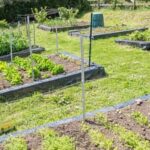A small zen garden with vegetables is a unique and beautiful concept that combines the tranquility of a traditional zen garden with the practicality of growing your own vegetables. For those seeking a peaceful and harmonious escape, these gardens offer a space for relaxation and stress relief while also providing nourishing, homegrown produce.
A small zen garden typically consists of carefully arranged stones, sand or gravel, and minimalist plants to create a serene environment. It is designed to promote mindfulness and meditation, allowing individuals to find inner peace amidst the chaos of everyday life. In this case, however, the garden takes on an additional purpose by incorporating various types of vegetables into its design.
The inclusion of vegetables in a small zen garden adds another layer of purpose and functionality. Not only does it provide aesthetic appeal, but it also allows you to grow your own food in a tranquil setting. Cultivating your own vegetables can bring a sense of fulfillment and joy as you witness the growth process from seed to harvest. It also offers the satisfaction of knowing exactly where your food comes from while prioritizing sustainability and self-sufficiency.
In the following sections, we will explore the benefits of small zen gardens with vegetables, provide guidance on selecting the ideal location for your garden, offer tips on designing and maintaining it effectively, discuss suitable vegetable options for small spaces, and even guide you through harvesting and enjoying the fruits (and vegetables) of your labor. By cultivating a small zen garden with vegetables, not only can you find tranquil moments amidst nature but also nourish yourself with homegrown goodness.
The benefits of small zen gardens with vegetables
Small zen gardens with vegetables offer a multitude of benefits for individuals seeking relaxation, stress relief, and the satisfaction of growing their own food. By combining the principles of zen gardening with vegetable cultivation, these small gardens can provide a sense of tranquility and nourishment.
Promoting relaxation and stress relief
One of the primary benefits of small zen gardens with vegetables is their ability to promote relaxation and reduce stress. The act of tending to these gardens allows individuals to engage in mindful activities such as sowing seeds, watering plants, and pruning foliage. By focusing on these tasks and connecting with nature, one can experience a sense of calm and escape from the stresses of daily life.
Furthermore, the presence of greenery has been proven to have a positive effect on mental well-being. Research shows that being around plants can lower blood pressure, improve mood, boost creativity, and enhance concentration. Small zen gardens with vegetables allow individuals to reap these benefits while also experiencing a greater connection to nature through the process of nurturing plant life.
The added benefits of growing your own vegetables
In addition to promoting relaxation and stress relief, small zen gardens with vegetables offer the added benefit of providing individuals with their own source of fresh produce. Growing your own vegetables not only allows you to enjoy healthier meals but also provides a sense of accomplishment and self-sufficiency.
By cultivating your own food, you have control over the use of pesticides and fertilizers, ensuring that your produce is organic and free from harmful chemicals. You can also experiment with different varieties that may be hard to find at grocery stores or farmers’ markets.
Moreover, growing your own vegetables can lead to cost savings in the long run. Rather than purchasing expensive organic produce from supermarkets, you can simply step into your garden and harvest what you need when it’s ripe.
Overall, small zen gardens with vegetables offer both tangible benefits in terms of providing fresh and wholesome food, as well as intangible benefits in terms of promoting peace of mind and mental well-being. By incorporating these gardens into our lives, we can find solace in the simplicity of nature while nurturing our bodies and souls.
Choosing the right location for your small zen garden with vegetables
When it comes to creating a small zen garden with vegetables, selecting the right location is crucial for the success of your garden. The ideal location will provide optimal growing conditions for your vegetables while also promoting relaxation and tranquility. Here are some factors to consider when choosing the perfect spot for your small zen garden:
- Sunlight: Most vegetable plants require at least 6 to 8 hours of direct sunlight each day. When scouting for a location, observe how much sunlight different areas of your yard receive throughout the day. Choose a spot that receives ample sunlight, especially during the morning hours. If your yard has limited sunny areas, consider using reflective surfaces or installing raised beds to maximize sunlight exposure.
- Drainage: Good drainage is essential for vegetable growth. Excessive water accumulation can lead to root rot and other fungal diseases that can harm your plants. Avoid low-lying areas in your yard that tend to retain water after rain or irrigation. Instead, select an area with well-draining soil or consider constructing raised garden beds with proper drainage systems.
- Accessibility: A convenient location is key to ensuring that you can easily tend to and maintain your small zen garden with vegetables. Choose a spot that is within easy reach from your home, minimizing the distance you’ll need to walk carrying tools or watering cans. Additionally, consider accessibility for pest control purposes as well as harvesting and enjoying the fresh produce from your garden.
| Factors | Tips |
|---|---|
| Sunlight | Choose a spot that receives at least 6-8 hours of direct sunlight each day |
| Drainage | Avoid low-lying areas and consider constructing raised beds with proper drainage systems |
| Accessibility | Select a spot that is within easy reach from your home for convenient maintenance and harvesting |
Remember to evaluate these factors when choosing the location for your small zen garden with vegetables. By providing optimal growing conditions, you’ll create a harmonious space where you can relax and enjoy the fruits of your labor.
Designing your small zen garden with vegetables
When it comes to designing your small zen garden with vegetables, there are several tips and considerations that can help create a peaceful and harmonious space. The goal is to combine elements of traditional zen gardens with practical vegetable gardening techniques.
One tip for creating a peaceful design is to keep it simple and uncluttered. Zen gardens are known for their minimalism and focus on natural materials. Choose a few key elements, such as rocks, gravel, and bonsai trees, to create a sense of tranquility. Designate specific areas for growing vegetables, using raised beds or containers that blend seamlessly with the overall aesthetic.
Another element to consider in your design is the balance of yin and yang. In traditional zen gardens, this balance is achieved through the placement of different elements and features. In your small zen garden with vegetables, you can achieve balance by alternating the types of plants or vegetables you grow, mixing tall and short plants or using different colors and textures. This creates visual interest while maintaining a sense of harmony in the space.
A key aspect of designing your small zen garden with vegetables is finding ways to incorporate both the aesthetics of a zen garden and the functionality of a vegetable garden. Consider incorporating elements such as bamboo fences or trellises for climbing plants like tomatoes or beans.
Use natural materials like wood or stone for pathways or borders around vegetable beds. By combining these two aspects, you can create a visually pleasing space that also provides nourishment through vegetables grown right in your own backyard.
Overall, designing your small zen garden with vegetables allows you to tap into the benefits of both meditation and gardening. With careful planning and attention to detail, you can create an outdoor sanctuary that promotes relaxation while also providing fresh produce for your meals.
| Considerations | Tips |
|---|---|
| Keep it simple and uncluttered | Choose a few key elements, such as rocks, gravel, and bonsai trees |
| Create balance of yin and yang | Alternate types of plants or vegetables, mix tall and short plants, use different colors and textures |
| Incorporate aesthetics and functionality | Use bamboo fences or trellises for climbing plants, natural materials like wood or stone for pathways or borders |
Selecting the ideal vegetables for your small zen garden
When it comes to selecting the ideal vegetables for your small zen garden, there are a few important factors to consider. First and foremost, it’s important to choose vegetables that are suited for small spaces. Since zen gardens are typically designed with simplicity and minimalism in mind, it’s best to select vegetables that don’t require a large amount of space to grow.
Some examples of vegetables that are well-suited for small gardens include leafy greens like lettuce, spinach, and kale. These vegetables can be grown in compact rows or even in containers, making them perfect for small spaces. Additionally, herbs such as basil, cilantro, and mint are also great options as they can be grown in pots or small raised beds.
In addition to considering the size of the vegetables you choose, it’s also important to select varieties that thrive in zen garden environments. Zen gardens often prioritize tranquility and balance, so it’s beneficial to choose vegetables that have a calming effect on the senses. For example, plants with soft textures or soothing colors can contribute to the overall peaceful atmosphere of the garden.
Furthermore, consider selecting vegetables that have a relatively low maintenance requirement. Zen gardens are meant to promote relaxation and stress relief, so opting for vegetable varieties that don’t require excessive care or attention can help achieve this goal. Vegetables such as radishes, green beans, and cherry tomatoes tend to be easier to grow and maintain compared to more high-maintenance crops.
By carefully selecting the ideal vegetables for your small zen garden, you can ensure a harmonious blend between aesthetics and practicality. Ultimately, aim for a selection of vegetables that not only thrive within the confines of your garden but also contribute to the overall sense of tranquility and nourishment that this unique gardening style promotes.
Planting and maintaining your small zen garden with vegetables
- Prepare the soil: Before planting, it’s important to prepare the soil in your small zen garden. Start by removing any weeds or debris from the area. Loosen the soil with a garden fork or tiller and add organic matter such as compost to improve its fertility.
- Choose your vegetables: Selecting the right vegetables for your small zen garden is crucial. Consider the size of your garden and choose plants that are well-suited for small spaces. Some ideal options include lettuce, spinach, radishes, carrots, and herbs like basil and parsley. These plants tend to grow well in containers or raised beds.
- Planting seeds or seedlings: Once you’ve chosen your vegetables, it’s time to plant them in your small zen garden. Follow the planting instructions on each seed packet or transplant seedlings into the prepared soil according to their recommended spacing requirements. Be sure to water them thoroughly after planting.
- Watering and fertilization: Proper watering is essential for the health of your vegetable plants in a small zen garden. It’s important to keep the soil evenly moist but not waterlogged. Irrigate deeply once or twice a week depending on weather conditions. Additionally, adding organic fertilizer periodically can help promote healthy growth.
- Pest control: Pests can be an issue in any garden, including small zen gardens with vegetables. Regularly inspect your plants for signs of pests such as aphids or snails, and take appropriate measures if necessary. Introducing beneficial insects like ladybugs or using natural pest control methods can help minimize damage without harming the environment.
- Maintenance: To ensure proper maintenance of your small zen garden with vegetables, regularly monitor the growth of your plants. Remove any weeds that may compete with your vegetables for nutrients and sunlight. Prune or trim plants as needed to encourage healthy growth and prevent overcrowding.
By following these steps, you can successfully plant and maintain your small zen garden with vegetables. As you tend to your garden, take the time to observe its beauty and find solace in the tranquility it provides. The process of nurturing your own food can bring immense joy and a sense of accomplishment as you harvest the fruits of your labor.
Harvesting and enjoying the fruits of your small zen garden
Once your small zen garden with vegetables is in full bloom, it’s time to reap the rewards of your hard work and enjoy the fresh produce that you’ve cultivated. Harvesting your vegetables at the right time ensures optimal flavor and quality. Here are some tips on when and how to harvest your vegetables from your small zen garden:
- Determine the right time for harvesting: Each vegetable has its own optimal harvesting time. For leafy greens like lettuce and spinach, they can generally be harvested when they have reached a desired size, typically before they start to bolt or develop a bitter taste. Root vegetables such as carrots and radishes can be pulled from the ground once they have reached maturity and developed a good size.
- Harvesting techniques: Use sharp pruners or scissors to carefully cut leafy greens just above the soil surface, taking care not to disturb nearby plants. Gently pull root vegetables out of the ground, holding onto the foliage near the base while pulling up to avoid damaging the roots.
- Proper handling and storage: After harvesting, it’s important to handle your vegetables with care to maintain their freshness. Remove any dirt or debris by gently rinsing them under cool water. Pat them dry with a clean towel before storing them in a cool location or refrigerator.
Now that you have harvested your fresh veggies, you can incorporate them into delicious meals that showcase their flavors. Here are some recipe ideas for using the produce from your small zen garden:
- Fresh salads: Toss together your harvested lettuce leaves along with other herbs like basil or mint for a refreshing salad packed with flavor.
- Stir-fries: Combine freshly picked bell peppers, snap peas, and zucchini for a colorful stir-fry that highlights the vibrant colors of your garden harvest.
- Veggie wraps: Use large leafy greens as wraps and stuff them with a variety of vegetables along with some protein like tofu or grilled chicken.
Remember to savor the fruits of your labor and enjoy the connection between nature, relaxation, and nourishment that your small zen garden with vegetables provides. By harvesting and utilizing your garden’s bounty, you can truly experience the rewards of this unique gardening practice.
Troubleshooting common issues in small zen gardens with vegetables
While small zen gardens with vegetables can provide a peaceful and nourishing experience, they are not without their own set of challenges. In this section, we will explore some common issues that may arise when cultivating these unique gardens and provide strategies for troubleshooting them.
One of the primary concerns in small zen gardens with vegetables is dealing with pests and diseases. Just like any other garden, these gardens are susceptible to insect infestations and plant diseases. However, due to the confined space of a small garden, the impact of these issues can be more significant. It is essential to regularly inspect your plants for any signs of damage or disease. Look out for pests such as aphids, snails, slugs, and caterpillars.
To address pest problems organically, you can introduce beneficial insects like ladybugs or lacewings that feed on pests or use natural remedies like neem oil or insecticidal soap. Additionally, practicing good garden hygiene by removing fallen leaves and debris can help prevent pest infestations.
Another common issue in small zen gardens with vegetables is maintaining balance and harmony in the garden. The integration of vegetable growth with traditional Zen elements requires careful planning to ensure unity between nature and spirituality. A key aspect of Zen gardening is simplicity, so it’s important not to overcrowd your garden with too many plants or complex design elements. Keep your plantings minimalistic and seek symmetry in your design.
Moreover, regular maintenance plays a crucial role in maintaining balance within the garden. Prune any overgrown vegetation to prevent overshadowing and promote healthy growth. Additionally, be mindful of watering habits and avoid overwatering which can disrupt the tranquility of the garden.
By being proactive in troubleshooting common issues such as pest control and maintaining balance within your small zen garden with vegetables, you can ensure its longevity and harmonious existence. Despite these challenges, the rewards of cultivating a thriving and serene garden filled with both beauty and nourishment are well worth the effort.
Conclusion
In conclusion, small zen gardens with vegetables offer a unique and fulfilling gardening experience. The combination of tranquil zen elements and the nourishment provided by growing your own vegetables creates a harmonious and fulfilling environment. These gardens provide various benefits, including relaxation, stress relief, and the satisfaction of cultivating your food.
By creating a peaceful and harmonious design, incorporating elements of both traditional zen gardens and vegetable gardening, you can transform your small space into a sanctuary of tranquility. Choosing the right location is crucial for the success of your garden, as factors such as sunlight and drainage greatly impact plant growth. With proper planning and consideration, you can maximize these elements to create an optimal growing environment for your vegetables.
Selecting the ideal vegetables suited for small spaces is another important step in creating a successful small zen garden. By choosing vegetables that thrive in this type of environment, you ensure a bountiful harvest while maintaining the serene atmosphere that these gardens are known for. Proper planting techniques, watering, fertilization, and pest control are essential for the prosperous growth and longevity of your plants.
Once you begin harvesting your fresh vegetables from your small zen garden, you will enjoy not only their delicious flavors but also the satisfaction of knowing that you grew them yourself. Incorporating these homegrown delights into meals adds an extra level of joy to the nourishment they provide.
Frequently Asked Questions
What do you put in a small Zen garden?
A small Zen garden typically consists of a few essential elements that help create a serene and meditative space. The main component is a shallow container or tray, usually made of wood, ceramic, or metal. In this container, you place fine-grained sand or gravel to represent the water element.
A rake is essential for creating patterns in the sand, symbolizing movement and waves. Additionally, small rocks or pebbles can be placed strategically to represent islands or focal points within the garden. Some people also like to add miniature figures or plants to enhance the aesthetic appeal and personal meaning of their small Zen garden.
What is the smallest Zen garden?
The smallest Zen garden can vary depending on personal preference and available space, but it generally consists of a compact design that captures the essence of a larger Zen garden on a miniature scale. One option for a small Zen garden is using a portable desk-sized meditation tray with around 8×8 inches dimension.
Such mini gardens often include everything found in larger ones but on a smaller scale: sand or gravel, rocks, miniature rake, and perhaps even figurines or plants if desired. Despite their diminutive size, these tiny Zen gardens can still provide a sense of tranquility and mindfulness.
How do you make a mini Zen garden?
Making your own mini Zen garden can be an enjoyable and creative process that allows you to personalize the design according to your preferences and available materials. To start, select an appropriately sized container such as a shallow wooden box or even a ceramic dish. Fill it with fine-grained sand or gravel; you may choose Japanese-inspired white sand for simplicity or go for colored varieties for added visual interest. Next, arrange miniature rocks or pebbles strategically within the sand to create focal points or represent islands in your miniature landscape.
Optionally, incorporate small figurines like Buddha statues or tiny plants like bonsai trees for an extra touch of inspiration. Finally, use mini rakes made from bamboo skewers or craft sticks to create patterns and texture in the sand, inviting a sense of calm and meditation. Remember that making a mini Zen garden offers the opportunity for personal expression and adaptation to suit your preferences, so feel free to experiment and explore what brings you the most peace and harmony.

If you’re looking to get into vegetable gardening, or are just looking for some tips on how to make your current garden better, then you’ve come to the right place! My name is Ethel and I have been gardening for years. In this blog, I’m going to share with you some of my best tips on how to create a successful vegetable garden.





